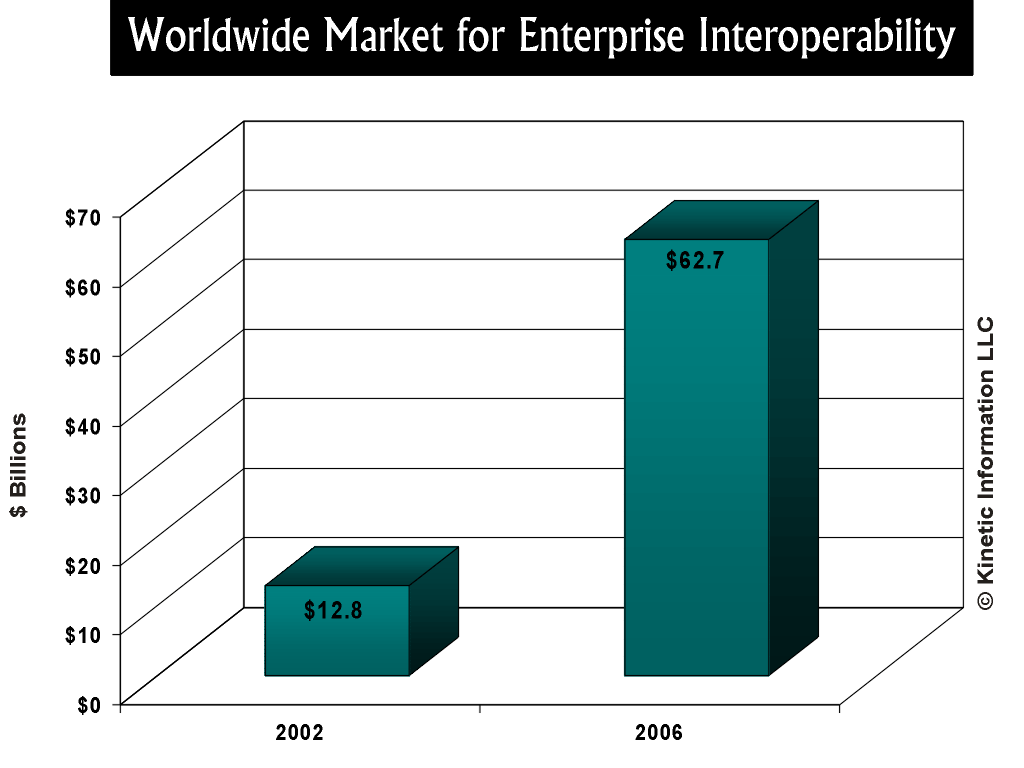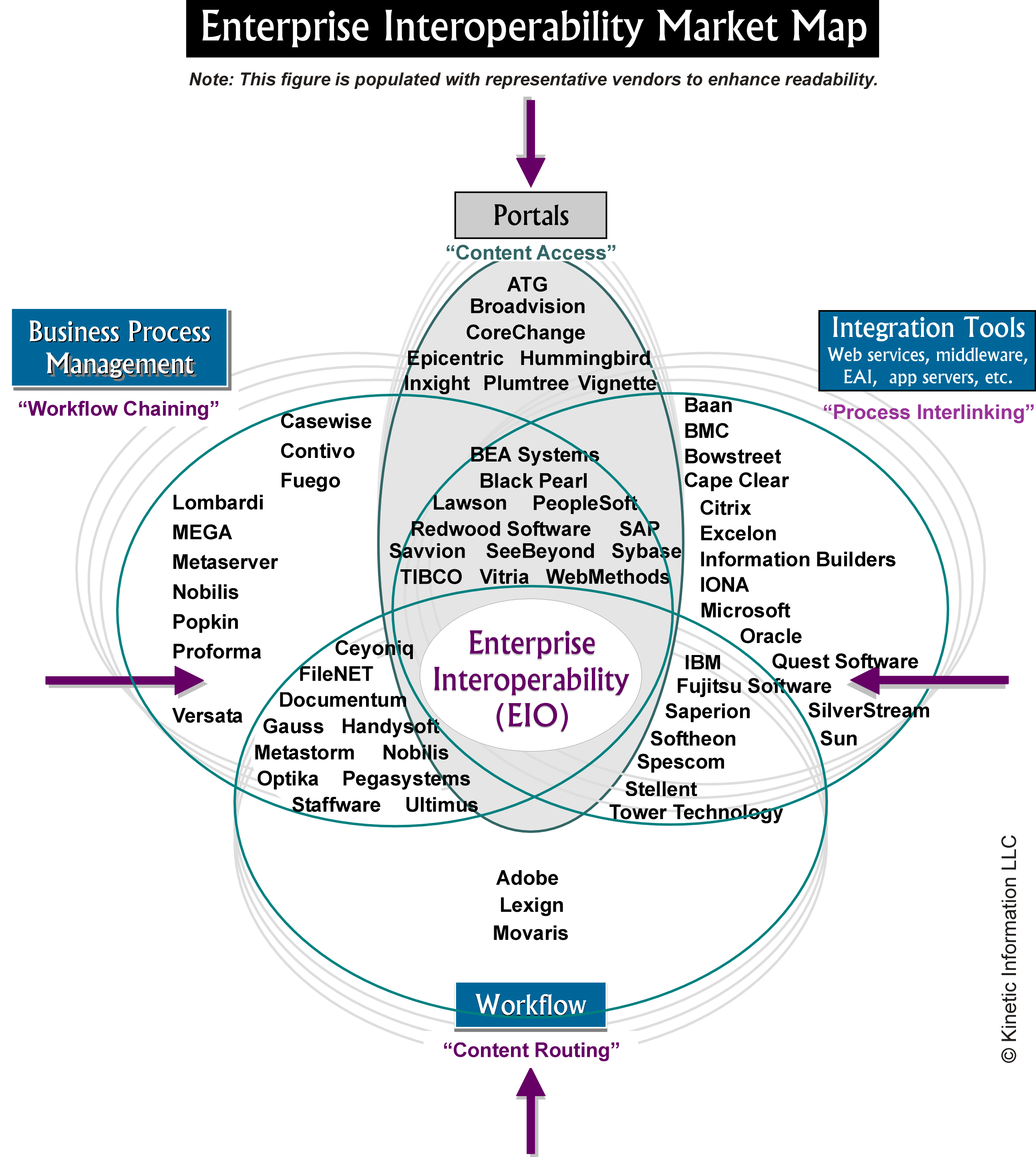Takes Center Stage
Enterprise Interoperability (EIO), n:
1. the ability to "get stuff to work together"
2. where process management, workflow,
portals & integration tools converge
The realities of todays economy, plus fallout from September 11-related world events, are giving a new urgency to customers need to integrate their business-critical systems. In some arenas, this need is bordering on compulsion as managers pursue strategies to improve operational efficiency and drive costs out of their businesses. In response, a new generation of connectivity software is arising to address the issue, and a huge new market for enterprise interoperability (EIO) $62+ billion worth by 2006 (see figure) is being created along the way.

EIO is Kinetic Informations umbrella term for various technologies that can be used to join systems together. It does not refer to any one, but rather embraces many different kinds that can be used, each in its own way, to get stuff to work together. We describe them as follows:
- Business Process Management (BPM) chains flows of work together to design and even simulate optimal business processes that frequently span multiple information systems. Often involved in the creation and management of individual procedures and sub-level tasks, BPM tools can be critical to building effective computing infrastructures and ensuring not only interoperability, but smooth systems management as well.
- Workflow enables interoperability by routing content from user to user according to a set of business rules. As such, it does not actually integrate anything, but loosely couples systems together so business objectives can be met. The goal here is to move data around, track its progress prompting for action when necessary and put it back when its done. Electronic forms, steeped in routing capabilities as they are, can be found here, as can elements of imaging, document management, and collaborative computing as well.
- Portals are effective aggregations of connectivity technologies that are orchestrated for the express purpose of providing access to content from a common point in other words, EIO for the front end. In Kinetic Informations view, portals represent a class of technology rather than a technology unto itself. However, they are a crucial part of the EIO landscape in that they present a common and often familiar interface through which users post and gather critical content and perform transactional activities that keep the business running.
- Integration Tools tightly-couple applications together to create integrated environments, usually by programmatic means. Essentially the connective tissue of the computing world, offerings in this arena include the likes of middleware, Web services, EAI, and application servers.
To be sure, each of these individual technologies works very differently from the others and would never be considered a direct replacement for any other. But because they can all be used to solve the same essential problem, they often are deployed in combination, and are paid for out of the same budget pool. Thus, they dont really spin in separate orbits the way we once thought; instead, they are part of a single market for EIO that revolves around enabling users to work with multiple systems as if they were only one.
This convergence is beginning to wreak dramatic change in the competitive landscape, and as it does, it is generating much confusion as buyers and sellers scramble to differentiate one offering from another, and as key players partner-up to better capture their fair share of the emerging market opportunity (see figure).

Outlining the Market Opportunity
EIO is a problem that touches all industries, all departments, and
all levels of management. It cant be addressed as a line item on one divisional
budget; rather the entire organization from R&D to manufacturing
to inventory to sales to human resources is involved, sometimes subtly
and sometimes blatantly, in achieving, maintaining, and improving interoperability
on system, process, and human levels. There is one budget for EIO the
corporate budget for IT and as just noted, very soon there will be but
one market.
Within that single market, vendors from each technology space will see growth through 2006. But most of them will gain traction by building, buying, or borrowing tools from other categories. These combined-technology sales, or converged solutions, will prove their worth in solving big pieces of the EIO puzzle, and in general will grab market share from pure-play technology solutions (see figure).
We expect the following six technology combinations to be most prevalent by 2006:
- BPM with Workflow
- BPM with Integration Tools
- BPM with Portals
- Workflow with Integration Tools
- Workflow with Portals
- Integration Tools with Portals
- EIO will be a platform play
- Transaction technology will move downmarket
- Web services will go from fad to fundamental
- Business activity monitoring is EIOs potential killer app
- ERP vendors will go mainstream
- Content technologies will turn commodity
- Storage will rebound as a network utility
- Symbiosis will emerge between wireless services and distributed software
 Kinetic
Information Home
Kinetic
Information Home